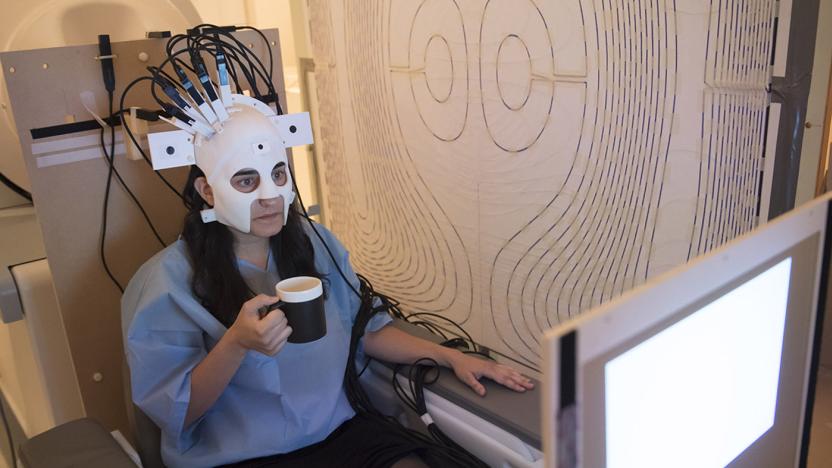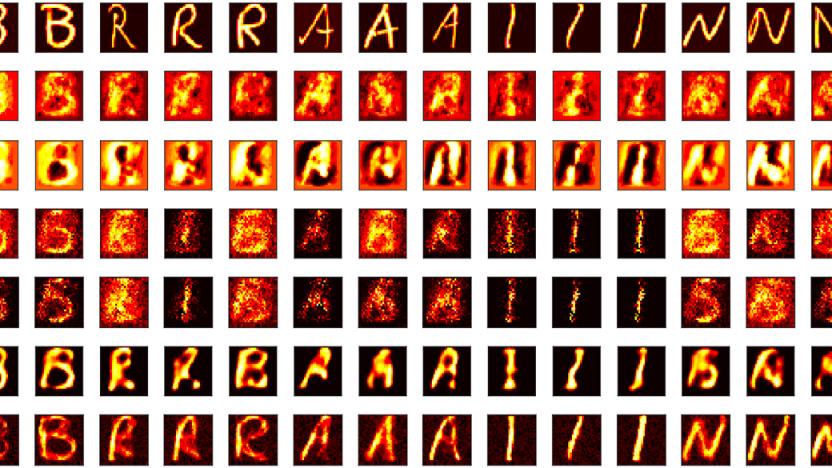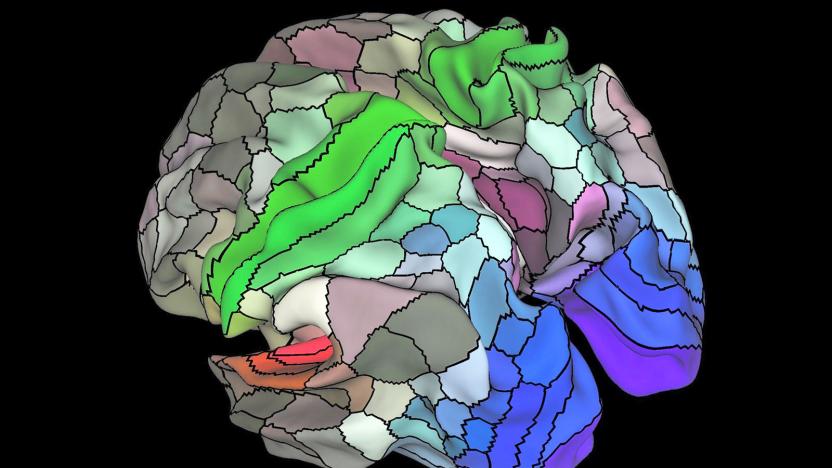brainscan
Latest

This funky helmet makes brain-scanning more comfortable
See that helmet in the photo up there? That's not a prop for a new sci-fi/horror flick -- it's a magnetoencephalography (MEG) helmet that can scan the brain and map its activity. MEG machines are used to look for pathological activity in patients with epilepsy and for brain tumor patients' surgical planning. The machines are typically, humongous, heavy and can't do their job if subjects don't stay perfectly still, which means it's hard to scan kids with epilepsy or people with Parkinson's and other movement disorders. This helmet designed by scientists from the University of Nottingham and University College London will work even if the patient is moving.

Neural network learns to reproduce what your brain sees
Scientists dream of recreating mental images through brain scans, but current techniques produce results that are... fuzzy, to put it mildly. A trio of Chinese researchers might just solve that. They've developed neural network algorithms that do a much better job of reproducing images taken from functional MRI scans. The team trains its network to recreate images by feeding it the visual cortex scans of someone looking at a picture and asking the network to recreate the original image based on that data. After enough practice, it's off to the races -- the system knows how to correlate voxels (3D pixels) in scans so that it can generate accurate, noise-free images without having to see the original.

Scientists map human brain in more detail than ever before
Scientists are still using a 100 year-old map to identify 83 known regions of the brain, but that's about to change. A team from Washington University in St. Louis, working with the Human Connectome Project, has plotted 97 new areas of our gray matter, bringing the total to 180. The updated map will help researchers better explore the brain and may lead to breakthroughs in autism, schizophrenia and other neurological disorders. "If you want to find out what the brain can do, you have to understand how it is organized and wired," says study leader Dr. David Van Essen.

Scientists study how the brain thinks about virtual avatars
This is fascinating stuff to think about over the weekend -- New Scientist has an article (sent to us by quite a few readers -- thanks!) about how we perceive our virtual selves in video games like World of Warcraft. A group of scientists at Dartmouth University hooked a few WoW players up to an MRI recently, and they found that when asked to describe themselves and their virtual avatars, the same areas of the brain activated -- areas normally suited to "self-reflection and judgement." In other words, you think about your avatar the same way you think about yourself. They found nearly no difference in the way the brain activated when subjects considered themselves and their avatars. But when you make the split between virtual and real worlds (including your friends in both), the brain's center for imagination tends to light up whenever you consider the virtual world. You've got the normal parts of your brain working when thinking about yourself or others, but when you add in the virtual component, the imagination center lights up as well.

Mice run through Quake, Princeton neuroscientists scan their brains for traces of evil (video)
Want to know just how prevalent technology has become in our lives? Now even lab mice get Quake-derived virtual reality playgrounds to navigate instead of their old school wooden mazes. In all honesty, this appears a significant and praiseworthy advancement, as the Princeton team have succeeded in mapping brain activity right down to the cellular level, with real-time tracking of single neurons now possible. The Orwellian-looking setup above is necessary in order to keep the mouse's head immobile, and thus capable of being studied, while the animal moves around and its brain performs motion-related tasks. Go past the break to see a schematic of the scanner and a quite unmissable video of it in action.[Via Switched]

Monkeys and scientists develop persistent "plug and play" control over brain-to-computer interface
While we've seen some pretty amazing things so far with computers jacked into human and monkey brains, systems so far have had to be re-learned each session by their subjects. In a new development, researchers at Berkeley have managed to get their monkeys to develop a "memory" for the controls, and recall them instantly each day. To do this, the scientists kept track of specific neurons from day to day -- a little tough to do, but obviously worth the hassle. It's good news for future brain-to-computer interfaces that will enable the disabled and the truly lazy to perform tasks and kick ass through the mere power of thought, but we're a little afraid of giving these monkeys too much in the way of internet access: the world doesn't need another 4chan.

Indian neuroscientist peers into a woman's brain, finds guilt
This is pure Philip K. Dick: in June a judge in India found a woman guilty of murdering her former fiancé and sentenced her to life in prison. The smoking gun? Test results obtained using the Brain Electrical Oscillations Signature test (BEOS) developed by Indian neuroscientist Champadi Raman Mukundan. The BEOS software uses an EEG to determine whether the subject is recalling specific details of a crime as they are being read aloud. BEOS "works" because as the crime's details are recited to a subject, their brain lights up in specific regions -- the areas that (in theory) show measurable changes when experiences are relived. According to Mukundan, the system can distinguish between peoples' memories of events they witnessed and deeds they committed. Gee, now that we have the technology to read criminal's minds and predict crimes we'll be expecting a crime-free society any minute now.Update: The headline error in the post has been fixed -- thanks commenters![Via Slashdot]

Computer designed to read thoughts from brain scans
Frighteningly enough, this isn't the first (or second) time that we've seen scientists pat themselves on the back for creating a mind-reading machine, but a dedicated team from Carnegie Mellon has just announced a computer that "has been trained to read people's minds by looking at scans of their brains as they thought about specific words." In a completely unsurprising move, gurus familiar with the development are suggesting that the breakthrough could be used to better understand how the brain organizes knowledge, and eventually, treat language disorders and learning disabilities more effectively. That's all gravy from here, but when this stuff starts passing as evidence in court, you'll know it's time to seriously investigate a relocation to Mars.

Fancy brain scans can detect when the mind wanders
What were we talking about again? Oh, that's right. Brains. Wonderful, delicious... brains. A new study published in the Proceedings of the National Academy of Sciences shows that researchers can track grey matter for the patterns that precede careless errors. Apparently there's a detectable activity shift when your brain switches to auto pilot -- which can happen as much as half a minute before you screw up. The hope behind the research is to be able to track brain activity and alert users who are headed off the tracks. The technology could reduce work slip-ups, improve driving, or at least help you know when to take a nap or switch activities to keep engaged. But seriously, what were we just talking about?

Neuroscientists read people's intentions with brain scan
Minority Report has proven itself to be a fairly prescient movie on more than one occasion and, as this latest development shows, it seems that researchers haven't mined those Dickian ideas dry just yet. While we've already seen some software that supposedly helped to predict future crimes, The Guardian is now reporting that a team of neuroscientists have brought pre-crime technology to a new, even creepier level, developing a brain scan that can purportedly read people's intentions before they act on them. It's apparently still a ways off from going into service, however, with tests of the technology currently centered around predicting a subject's response to a simple math question. Nonetheless, the researchers seem to be well aware of the technology's potentially more complex uses, and are calling for an ethical debate over its possible use in interrogation. On the flipside, they also see the technology eventually being used in some less ethically-challenging applications, such as helping people control artificial limbs or operate a computer simply by thinking about it.

Thought-based biometrics system underway?
Seems kind of old school if your brain interface doesn't provide extra-sensory enhancement or integration to robotic limbs, but researchers at Carleton University in Ottawa, Canada are working on a system for thought-based biometrics by scanning and interpreting each individual's unique brain-wave signatures that occur when they think of a certain thought or can identify patterns uniquely -- kind of like that Peter Pan pixie dust thing, except in this case you get granted access to your box. For a variety of reasons the system isn't without its doubts and detractors, and will probably continue to have them so long as you have to wear an EEG cap on your scalp to get a reading -- though according to UCLA professor and BCI expert Jacques Vidal, rocking that headgear's the least of this system's problems. But if you expect us to shrug off any system that lets us interface with our gear via mind-link, you're sorely mistaken. So keep at it Carleton U, let's see some thought scanners.





